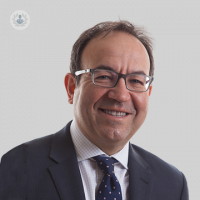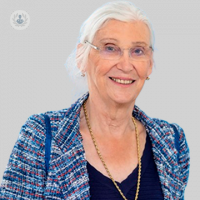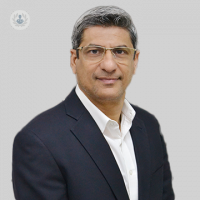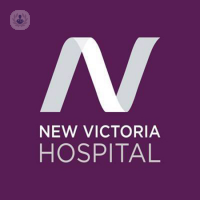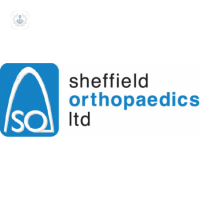
What is arthroplasty?
The term arthroplasty refers to any surgical procedure to restore the function of a damaged joint, often by replacing them with artificial joints made of chromium, cobalt and titanium, along with high density plastics.
The ultimate aim of arthroplasty is to correct deformities, reduce or eliminate pain in the affected areas, and restore mobility. Arthroplasty is commonly performed on the hip, knee, elbow, shoulder, and ankle, among others.
Different types of arthroplasty include:
- Joint replacement – the damaged joint is removed and replaced with a prosthesis. Hip replacements and knee replacements are the most common.
- Interpositional arthroplasty – tissue, such as skin or muscle is interposed to keep inflammatory surfaces from rubbing together.
- Excisional arthroplasty – bone is removed from the surface of the joint to stop the bones making contact. Scar tissue is left to fill the gap.
- Resurfacing arthroplasty – the surfaces of the bones at the joint are replaced with a smooth, protective metal coating.
Why is arthroplasty done?
Arthroplasty is carried out to replace the damaged joint with a healthy one, allowing the patient to live a full and active life with adequate mobility.
Arthoplasty may become necessary due to:
- Rheumatoid arthritis
- Osteoarthritis
- Osteoporosis
- Osteonecrosis
- Misaligned joints (often due to traumatic injury)
What does arthroplasty consist of?
Arthroplasty procedures are carried out under general anaesthetic. The patient’s heart rate, blood pressure, breathing, and blood oxygen are monitored, while the surgeon makes an incision and removes and/or repairs the damaged parts of the joint, before closing the incision with stitches.
The process of placement of the prosthesis will be different depending on the type of joint replacement.
Preparation for arthroplasty
No special preparation is required for arthroplasty, other than notifying the specialist of the possibility of being pregnant and the medication the patient is taking, which may be strong in cases of rheumatic diseases and may need to be stopped or changed prior to the operation.
Care after the intervention
After the intervention, the patient may feel pain, which is normal in any intervention. In case of pain, the specialist will recommend the best treatment.
During the hospitalisation, specialists will soon begin to move the joint, so that recovery is as effective as possible and the patient regains mobility as soon as possible.
After being discharged from the hospital, the patient must go for rehabilitation for a few months to fully recover the mobility of the joint and also to check that make sure that the prosthesis is functioning properly.
03-26-2013 02-23-2024Arthroplasty
Mr Jordi Sanchez-Ballester - Orthopaedic surgery
Created on: 03-26-2013
Updated on: 02-23-2024
Edited by: Aoife Maguire

What is arthroplasty?
The term arthroplasty refers to any surgical procedure to restore the function of a damaged joint, often by replacing them with artificial joints made of chromium, cobalt and titanium, along with high density plastics.
The ultimate aim of arthroplasty is to correct deformities, reduce or eliminate pain in the affected areas, and restore mobility. Arthroplasty is commonly performed on the hip, knee, elbow, shoulder, and ankle, among others.
Different types of arthroplasty include:
- Joint replacement – the damaged joint is removed and replaced with a prosthesis. Hip replacements and knee replacements are the most common.
- Interpositional arthroplasty – tissue, such as skin or muscle is interposed to keep inflammatory surfaces from rubbing together.
- Excisional arthroplasty – bone is removed from the surface of the joint to stop the bones making contact. Scar tissue is left to fill the gap.
- Resurfacing arthroplasty – the surfaces of the bones at the joint are replaced with a smooth, protective metal coating.
Why is arthroplasty done?
Arthroplasty is carried out to replace the damaged joint with a healthy one, allowing the patient to live a full and active life with adequate mobility.
Arthoplasty may become necessary due to:
- Rheumatoid arthritis
- Osteoarthritis
- Osteoporosis
- Osteonecrosis
- Misaligned joints (often due to traumatic injury)
What does arthroplasty consist of?
Arthroplasty procedures are carried out under general anaesthetic. The patient’s heart rate, blood pressure, breathing, and blood oxygen are monitored, while the surgeon makes an incision and removes and/or repairs the damaged parts of the joint, before closing the incision with stitches.
The process of placement of the prosthesis will be different depending on the type of joint replacement.
Preparation for arthroplasty
No special preparation is required for arthroplasty, other than notifying the specialist of the possibility of being pregnant and the medication the patient is taking, which may be strong in cases of rheumatic diseases and may need to be stopped or changed prior to the operation.
Care after the intervention
After the intervention, the patient may feel pain, which is normal in any intervention. In case of pain, the specialist will recommend the best treatment.
During the hospitalisation, specialists will soon begin to move the joint, so that recovery is as effective as possible and the patient regains mobility as soon as possible.
After being discharged from the hospital, the patient must go for rehabilitation for a few months to fully recover the mobility of the joint and also to check that make sure that the prosthesis is functioning properly.
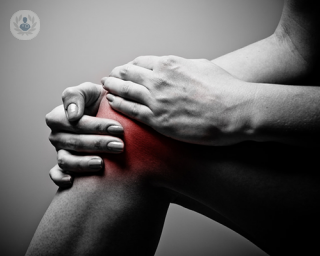

All you need to know about knee replacement surgery
By Mr Saman Horriat
2025-01-16
Knee replacement surgery is a procedure that may be necessary in patients who have arthritis. Here to provide an expert insight into knee replacement surgery, including risks and recovery, is Mr Saman Horriat, highly esteemed consultant trauma and orthopaedic surgeon. See more
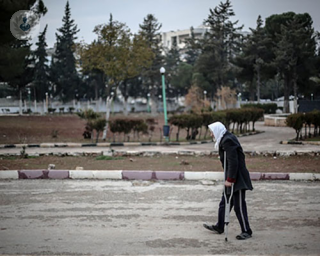

Insights into arthroplasty
By Mr Tom Symes
2025-01-16
In his latest online article, Mr Tom Symes gives us his insights into arthroplasty. He talks about what it is, when and why its needed, how long it takes, side effects or risks and recovery. See more


Knee arthroplasty: when is it needed and is it safe?
By Mr Rohit Jain
2025-01-15
You might be wondering how safe a knee arthroplasty is, what the risks are and when the procedure is needed. Find out how successful this procedure is at treating knee issues. Mr Rohit Jain, a leading orthopaedic hip and knee surgeon highlights things you need to know before considering knee arthroplasty See more


Rehabilitation following reverse polarity arthroplasty
By Mr Paolo Consigliere
2025-01-15
Revered consultant shoulder and elbow orthopaedic surgeon Mr Paolo Consigliere discusses the rehabilitation regime that he encourages after reverse polarity arthroplasty. See more
Experts in Arthroplasty
-
Ms Sarah Muirhead-Allwood
Orthopaedic surgeryExpert in:
- Hip replacement
- Hip prosthesis
- Arthroplasty
- Osteoarthritis of the hip
- Anterior hip replacement
-
Mr Jehangir Mahaluxmivala
Orthopaedic surgeryExpert in:
- Knee replacement
- Hip replacement
- Knee osteoarthritis
- Osteoarthritis of the hip
- Knee arthroscopy
- Arthroplasty
-
Mr Richard Hill
Orthopaedic surgeryExpert in:
- Shoulder
- Elbow
- Arthroplasty
- Hip replacement
- Shockwave therapy
- Platelet-rich plasma
-
Professor Stefano Zanasi
Orthopaedic surgeryExpert in:
- Knee surgery
- Knee osteoarthritis
- Robotic surgery
- Stem cells
- Prolotherapy
- Arthroplasty
-
Mr Jordi Sanchez-Ballester
Orthopaedic surgeryExpert in:
- Ankle
- Foot
- Knee arthroscopy
- Arthroplasty
- Knee surgery
- Osteoarthritis
- See all

New Victoria Hospital
New Victoria Hospital
184 Coombe Lane West, Kingston upon Thames, KT2 7EG
No existe teléfono en el centro.
By using the telephone number provided by TOP DOCTORS, you automatically agree to let us use your phone number for statistical and commercial purposes. For further information, read our Privacy Policy
Top Doctors

Goring Hall Hospital - part of Circle Health Group
Goring Hall Hospital - part of Circle Health Group
Bodiam Ave, Goring-by-Sea, Worthing BN12 5AT
No existe teléfono en el centro.
By using the telephone number provided by TOP DOCTORS, you automatically agree to let us use your phone number for statistical and commercial purposes. For further information, read our Privacy Policy
Top Doctors

Sheffield Orthopaedics Ltd
Sheffield Orthopaedics Ltd
Claremont Hospital, 401 Sandygate Rd, Sheffield
No existe teléfono en el centro.
By using the telephone number provided by TOP DOCTORS, you automatically agree to let us use your phone number for statistical and commercial purposes. For further information, read our Privacy Policy
Top Doctors
-
New Victoria Hospital
184 Coombe Lane West, Kingston upon Thames, KT2 7EG, South LondonExpert in:
- Cardiology
- General Surgery
- Orthopaedic surgery
- Breast augmentation
- Pain management
- Spine
-
Goring Hall Hospital - part of Circle Health Group
Bodiam Ave, Goring-by-Sea, Worthing BN12 5AT, Goring-by-SeaExpert in:
- Hip
- Cataracts
- Gallbladder surgery
- General Surgery
- Orthopaedic surgery
- Hernia
-
Sheffield Orthopaedics Ltd
Claremont Hospital, 401 Sandygate Rd, Sheffield, SheffieldExpert in:
- Hip
- Orthopaedic surgery
- Orthopaedic spinal surgery
- Shoulder and elbow
- Joint replacement
- See all
- Most viewed diseases, medical tests, and treatments
- Trigeminal neuralgia
- Alzheimer's disease
- Cluster headaches
- Tension headache
- Chronic headache
- Ulnar nerve entrapment
- Peripheral nerve block
- Peripheral neuropathy
- Facial feminisation surgery
- Joint pain
